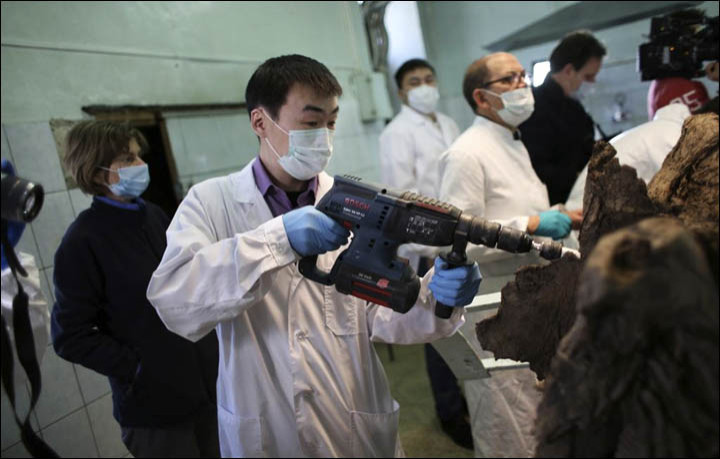Cloning extinct species: Scientists turn to mammoth skin cells after failing to find intact cells in bone

After failing to find well-preserved cells from the bone marrow of a 28,000-year-old woolly mammoth, scientists are now looking at recovering intact cells from the animal's skin to clone the extinct species.
Earlier attempts to extract the nucleus from the skin cells had destroyed the cells, but the team is hopeful of success with more samples procured, said Dr Hwang Woo Sul, chief of South Korea's Sooam Biotech Research Foundation.
Tuesday (24 March) saw the opening of Russia's North-Eastern Federal University (NEFU) in Yakutsk, the first-ever centre for studying the DNA of mammoths and other extinct species.
The remains were discovered in May 2013, having been frozen for about 28,000 years on an Arctic island off the diamond-rich Sakha Republic in Russia.
The carcass with the perfectly-preserved trunk is thought to belong to a female aged between 50 and 60.
The "Revival of Mammoth" project is being implemented in two ways. One is by cloning which requires live cells that are cultured and implanted into a close relative of the extinct species.
With most extinct species, even if the embryos can be constructed, there are no appropriate surrogate mothers.
In the mammoth's case, the scientists are looking at an Asian elephant surrogate.
The second route of de-extinction is by studying the mammoth DNA sequence and creating artificial living cells.
A mammoth nuclear DNA is made up of 40 to 45 million nucleotides. Building the stuff in the lab is a tough physical process and expected to take years.
"We will continue the search for new materials and samples. We need a cell that can share information. If we can find a sample that is not only well preserved, but in which biochemical processes take place, we will be able to fertilise an Asian elephant using selected materials," Sui said.
The deputy Director of the Zoological Institute of the Russian Academy of Sciences, Aleksey Tikhonov, was more cautious over success in cloning extinct species.
"Firstly, if the organism is dead, there cannot be any living cells. When we talk about living cells we mean the intact cells, namely, cells that have retained their membrane structure and nucleus. It is believed that this is enough to try to carry out the procedure of cloning," he told the Siberian Times.
However, he is optimistic about the development of local science.
The woolly mammoth was a species of mammoth, the extinct elephant genus Mammuthus, that once lived across the northern latitudes till it went extinct around 1700 BC .
Cloning extinct species
The first such clone of an extinct species was created in 2003 but the animal died within minutes due to respiratory problems.
Even there, it was frozen skin that was used to clone the bucardo, or Pyrenean ibex, a subspecies of Spanish ibex that went extinct in 2000.
Clone embryos were made by inserting the bucardo's DNA into domestic goat eggs emptied of their original genetic material. Of the 208 embryos the researchers implanted, only seven goats became pregnant, and just one bucardo made it to term.
The scientists have not given up and have started work again using the last bucardo's cells maintained frozen in liquid nitrogen for 15 years.
The cloned embryos will be implanted in female goats.
A precise gene editing technique known as Crispr has opened up new opportunities in the field of
endangered species conservation and de-extinction. Scientists at Harvard led by geneticist George Church claim to have successfully inserted the woolly mammoth DNA into the Asian elephant.
Ironically, with all the attempts to revive extinct species, the world is on way to lose the African elephant within a few decades, reports AFP from a recent international meet where experts voiced concern over rampant poaching of the species for its ivory.
Latest figures from the International Union for Conservation of Nature report that the African elephant population had dropped from 550,000 in 2006 to 470,000 in 2013.
© Copyright IBTimes 2025. All rights reserved.





















